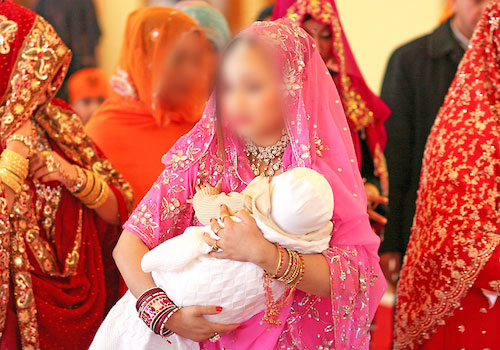
The birth of a child is a moment of immense joy and gratitude for any family. In Sikhism, this joy is accompanied by deep spiritual significance. The Sikh baby naming ceremony, known as Naam Karan, is not just a tradition but a sacred ritual that connects the newborn with Guru Granth Sahib, the eternal Guru of the Sikhs. Unlike many cultures where names are chosen based on personal preferences or astrological beliefs, Sikh names are derived from the divine wisdom of the Guru. This practice ensures that the child’s name carries a spiritual meaning, guiding them towards a life of righteousness, humility, and devotion.

The Naam Karan ceremony is typically held in a Gurudwara (Sikh place of worship) in the presence of the Sangat (holy congregation). The event revolves around the Hukamnama, a divine verse from Guru Granth Sahib, which determines the first letter of the child’s name. This sacred process symbolizes surrender to the Guru’s will, affirming that the child’s life will be guided by divine principles.
In this book, we will explore the significance of Sikh names, the preparations for the Naam Karan ceremony, a detailed step-by-step guide on how it is performed, and the spiritual wisdom behind the tradition. Whether you are a new parent, a member of the Sikh community, or someone interested in Sikh customs, this book will provide valuable insights into the beautiful and profound ritual of Sikh baby naming.
Names play a powerful role in shaping an individual’s identity, and in Sikhism, they hold even greater importance. A name is not just a way to identify a person; it is a reflection of Gurmat (Guru’s teachings) and a constant reminder of one’s spiritual path. Sikh names are derived from Gurbani (sacred hymns) and often include references to God, divine virtues, and moral strength.
For example, names like Gurpreet (lover of the Guru), Harleen (absorbed in God’s love), and Jasmeet (one who sings praises of the Lord) all have deep spiritual meanings. Every Sikh name is gender-neutral, and the suffixes Singh (Lion) for boys and Kaur (Princess) for girls emphasize equality in the Sikh faith. The Guru has provided a structured yet simple way of naming children that aligns them with the divine path from the very beginning.
The tradition of naming children based on the Guru’s teachings dates back to Guru Nanak Dev Ji, the first Sikh Guru. He emphasized the power of Naam (God’s Name) in attaining spiritual enlightenment. By receiving a name from the Guru Granth Sahib, Sikh children are blessed with a lifelong connection to the divine.
The Naam Karan ceremony is a significant spiritual event in the life of a Sikh child, and preparing for it requires careful planning. The ceremony is usually held within the first 40 days of the child’s birth, but there is no strict timeline. Some families choose to conduct it earlier, while others may wait a little longer, depending on personal circumstances. However, it is essential that the ceremony is conducted in accordance with Sikh traditions and in the presence of Guru Granth Sahib.
The most preferred place for the Naam Karan ceremony is the Gurdwara, where the presence of Guru Granth Sahib and the holy congregation (Sangat) makes the occasion even more divine. The Gurudwara provides a peaceful and spiritual environment, allowing the family and guests to participate in the ceremony with devotion. Additionally, the availability of Kirtan (hymn singing) and Guru Ka Langar (community meal) makes it a complete religious experience.
However, in certain situations, such as when the mother or child is unwell or if there is no nearby Gurdwara, the ceremony can also be conducted at home. In such cases, Guru Granth Sahib is respectfully brought to the house, and the Hukamnama (divine order) is taken in the same manner as it would be in the Gurdwara.
Since the Naam Karan is a religious event, it is customary to invite family members, close friends, and members of the Sikh community to join in the celebration. Invitations are usually extended in a simple and respectful manner, with an emphasis on Sewa (selfless service) and Sangat (community participation) rather than grand celebrations.
The focus should remain on the spiritual aspect of the ceremony rather than material extravagance.No Sikh religious event is complete without Karah Parshad and Guru da Langar, the sacred offering blessed by the Guru. Karah Parshad is prepared using equal portions of flour, sugar, and ghee, signifying equality, unity, and divine sweetness. The family usually takes responsibility for preparing or arranging the Parshad to be distributed after the ceremony.
Another essential part of the Naam Karan ceremony is Guru Ka Langar, the community meal served to all attendees regardless of caste, religion, or social status. Some families choose to organize a Sehaj Path (completion of continuous reading of Guru Granth Sahib) or Kirtan (hymn singing) as part of the Naam Karan ceremony, further enriching the spiritual atmosphere.
Before attending the ceremony, family members, especially parents, are encouraged to engage in Simran (meditation on God's Name) and recitation of Gurbani to prepare themselves spiritually. The birth of a child is a divine blessing, and this ceremony is an opportunity to express gratitude to the Guru. Parents should approach the Naam Karan with humility and devotion, recognizing that they are placing their child under the guidance of Guru Granth Sahib.
With all the preparations complete, the family and guests gather at the Gurudwara for the actual Naam Karan ceremony. The next chapter will describe the step-by-step process of the Sikh baby naming ceremony, highlighting its deep spiritual significance.
The Naam Karan ceremony is a deeply spiritual event that follows a well-defined process based on Sikh traditions. The entire ceremony revolves around Guru Granth Sahib, the eternal Guru of the Sikhs, who plays a central role in choosing the child’s name. Below is a step-by-step guide to how the Naam Karan ceremony is performed.
On the day of the ceremony, the family, relatives, and invited guests gather at the Gurudwara Sahib. The newborn baby, along with their parents, is welcomed into the congregation (Sangat) with love and joy. The atmosphere is filled with Gurbani Kirtan (devotional hymns) that bring peace and devotion to the hearts of everyone present.
If the ceremony is being conducted at home, the family ensures that Guru Granth Sahib is respectfully installed, and the home is prepared as a sacred space.
Once the family is seated, a Giani (priest or knowledgeable Sikh elder) leads the Sangat in Ardas, a special prayer seeking blessings from Akal Purakh (the Almighty God) and Guru Granth Sahib. This prayer expresses gratitude for the birth of the child and seeks divine guidance for their life.
In the Ardas, the parents humbly present their newborn before the Guru and pray for the child’s well-being, good health, and a life filled with Gurmat values (Guru’s teachings).
After the Ardas, the Granthi (scripture reader) opens Guru Granth Sahib at a random page. The first Shabad (hymn) on the opened page is read aloud. The first letter of the first word of the Hukamnama determines the child’s name.
For example, if the Hukamnama begins with the word "Waheguru", the family may choose a name that starts with the letter W (e.g., Warinder, Waryam, Waneet).
This process symbolizes surrender to the Guru’s will, as the name is chosen based on divine guidance rather than personal preference.
Once the first letter is revealed, the parents, along with family members, select a suitable name that begins with the given letter. Sikh names often reflect virtues such as courage, devotion, wisdom, and humility.
Sikh names are unisex, meaning they can be used for both boys and girls. However, boys are traditionally given the middle or last name “Singh” (meaning lion), and girls are given “Kaur” (meaning princess). This practice emphasizes the Sikh principle of equality and eliminates the need for caste-based surnames.
For example:
After selecting the name, the Mool Mantar, the fundamental verse of Sikhism, is recited by the Granthi and repeated by the Sangat. This serves as the child’s first spiritual lesson, reminding them of the one eternal God. The Mool Mantar is:
"Ik Onkar, Satnam, Karta Purakh, Nirbhau, Nirvair, Akal Murat, Ajooni, Saibhang, Gur Prasad."
This powerful verse forms the foundation of Sikh belief and will guide the child throughout their life.After the Naam Karan is completed, Karah Parshad, the sacred offering made from wheat flour, sugar, and ghee, is distributed to everyone present. It signifies the Guru’s blessings and the sharing of divine grace.
A final Ardas is performed to conclude the ceremony, thanking Guru Sahib for bestowing a name upon the child. The Sangat then blesses the newborn and offers good wishes to the parents. Elders may recite Sikh teachings or encourage the family to raise the child with Sikh values and traditions.
After the ceremony, everyone partakes in Guru Ka Langar, the free community meal served in every Gurdwara. This meal symbolizes equality, humility, and unity among all people, regardless of background. The family may choose to perform Sewa (selfless service) by helping serve Langar or cleaning the Gurudwara premises as a gesture of gratitude.